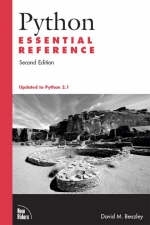
Python Essential Reference
Sams Publishing (Verlag)
978-0-7357-1091-7 (ISBN)
- Titel erscheint in neuer Auflage
- Artikel merken
Python Essential Reference, Second Edition, is the definitive guide to the Python programming language. Designed for programmers, it covers the core language, more than 100 modules in the standard library, and the techniques used to extend Python with compiled procedures in C or C++. Coverage expands upon and clarifies existing Python documentation - especially for advanced topics, including operating system interfaces, threads, network programming, and Unicode.
Concise, to the point, and extensively indexed, readers will find this volume packed with information not previously available in any other single reference source. Updated for Python 2.1, it is a must-have for any serious programmer wanting to develop advanced Python applications.
As a comprehensive reference to the Python programming language, this book will help you:
Learn about the features in Python 2.0 and 2.1
Master the details of Python types, operators, and the execution model
Discover the details of Unicode and internationalization support
Learn the details of operating system interfaces, threads, and network-programming modules
Build C/C++ extensions to Python
Make effective use of the Python library
Find the information you need to start developing advanced Python applications
David M. Beazley is the developer of SWIG, a popular software package for integrating C programs with interpreted languages including Python, Perl, and Tcl. He has been actively involved with the Python community since 1996 and is currently working on projects related to mixed-mode debugging of scripting language extensions. Dave spent seven years working in the Theoretical Physics Division at Los Alamos National Laboratory, where he helped pioneer the use of Python with high-performance simulation software running on parallel computers. He is currently an assistant professor in the Department of Computer Science at the University of Chicago, where he enjoys tormenting students with insane programming projects in operating systems, networks, and compilers courses. He can be reached at beazley@cs.uchicago.edu.
1. A Tutorial Introduction.
Running Python. Variables and Arithmetic Expressions. Conditionals. File Input and Output. Strings. Lists and Tuples. Loops. Dictionaries. Functions. Classes. Exceptions. Modules.
2. Lexical Conventions and Syntax.
Line Structure and Indentation. Identifiers and Reserved Words. Literals. Operators, Delimiters, and Special Symbols. Documentation Strings.
3. Types and Objects.
Terminology. Object Identity and Type. Reference Counting and Garbage Collection. References and Copies. Special Methods Performance and Memory Considerations.
4. Operators and Expressions.
Operations on Numbers. Operations on Sequences. Operations on Dictionaries. Augmented Assignment. The Attribute (.) Operator. Type Conversion. Unicode Strings. Boolean Expressions and Truth Values. Object Equality and Identity. Order of Evaluation. Conditionals. Loops.
5. Control Flow.
Exceptions. Defining New Exceptions. Assertions and _ _debug_ _. Functions.
6. Functions and Functional Programming.
Parameter Passing and Return Values. Scoping Rules. Recursion. The apply() Function. The lambda Operator. map(), zip(), reduce(), and filter(). List Comprehensions. eval(), exec, execfile(), and compile(). The class statement.
7. Classes and Object-Oriented Programming.
Class Instances. Reference Counting and Instance Destruction. Inheritance. Polymorphism. Information Hiding. Operator Overloading. Classes, Types, and Membership Tests.
8. Modules and Packages.
Modules. The Module Search Path. Module Loading and Compilation. Module Reloading. Packages.
9. Input and Output.
Reading Options and Environment Variables. Files. Standard Input, Output, and Error. The print Statement. Persistence. Unicode I/O. Interpreter Options and Environment.
10. Execution Environment.
Interactive Sessions. Launching Python Applications. Site Configuration Files. Enabling Future Features. Program Termination.
A. The Python Library.
Built-in Functions and Exceptions. Mathematics. String Handling. Data Management and Object Persistence. Operating System Services. Threads. Network Programming. Internet Data Handling and Encoding. Restricted Execution. Miscellaneous Modules. The Python Debugger. The Python Profiler. Undocumented Modules.
B. Extending and Embedding Python.
Enabling Optional Modules. Compilation of Extensions. Converting Data from Python to C. Converting Data from C to Python. Error Handling. Reference Counting. Calling Python from C. Abstract Object Layer. Low-Level Functions on Built-in Types. Defining New Types. Special Methods for Types. Threads. Embedding. Extension Building Tools.
C. Summary of Changes.
Python 1.6. Python 2.0. Python 2.1.
Index.
| Erscheint lt. Verlag | 28.6.2001 |
|---|---|
| Verlagsort | Indianapolis |
| Sprache | englisch |
| Maße | 152 x 229 mm |
| Gewicht | 549 g |
| Themenwelt | Mathematik / Informatik ► Informatik ► Programmiersprachen / -werkzeuge |
| Informatik ► Software Entwicklung ► Objektorientierung | |
| ISBN-10 | 0-7357-1091-0 / 0735710910 |
| ISBN-13 | 978-0-7357-1091-7 / 9780735710917 |
| Zustand | Neuware |
| Haben Sie eine Frage zum Produkt? |
aus dem Bereich


